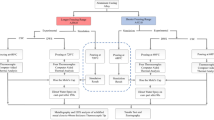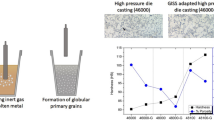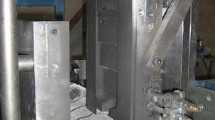Abstract
This work examines the quality aspects of multiple gated castings in aluminum A356 alloys. During the casting of parts in which multiple ingates are used to distribute the liquid melt throughout the mold, oxidation of the surface may prevent the adherence of the opposing fronts upon rejoining, thus producing sites prone to defect formation referred to as confluence welds. This phenomenon is investigated by the production of thin vertically sand-cast plates via the Electromagnetic Pump Green Sand (EPGS) process developed by the Foundation for the Research and Development in Transport and Energy (CIDAUT), Valladolid, Spain. For this research, three multiple-gated designs and one single-gated design were used to research an optimal configuration for melt delivery throughout the mold cavity. A series of numerical simulations were developed for each of the gating designs in order to compare modeling results with plates cast in the overseas counterpart’s foundry. Four-point bend testing was used to obtain information about the mechanical properties of the castings, and from this data, a Weibull statistical analysis was performed in order to quantify specimen failure rate for each of the configurations. Metallographic analysis was carried out using optical microscopy and fractography using a field emission gun scanning electron microscope (FEG-SEM). The numerical and experimental studies provided interesting insights on the formation of defects associated with the confluence of flow fronts.
Similar content being viewed by others
References
Campbell, J., Castings 2ndEdition — The New Metallurgy of Cast Metals. Butterworth-Heinemann, Oxford, UK (2003).
Barkhudarov, M., Hirt, C.W., Proc. Materials Solutions Conference on Aluminum Casting Technology, IL, USA (1998).
Berry, J.T., Luck, R., “Porosity Criteria Functions Revisited,” 2006 World Foundry Congress, 4–7 June, Harrogate, UK
Nyahumwa, C., Green, N.R., Campbell, J., “Effect of Mold-Filling Turbulence on Fatigue Properties of Cast Aluminum Alloys,” AFS Transactions, vol. 106, pp. 215–223 (1998).
Cuesta, R., Martin, J., Maroto, J.A., “New Casting Process: The EPGS Process: The Science and Technology of Casting Production,” Foundry Trade Journal, pp. 66–70 (March 2008).
Campbell, J., Castings Practice — The 10 Rules of Castings, Butterworth-Heinemann, Oxford, UK (2004).
Sessler, J.G., Aerospace Structural Metals Handbook, vol. 3, code 3105, rev. June 1969 (1991).
Cuesta, R., Delgado, A., Maroto, J.A., Mozo, D., “Numerically Modeling Oxide Entrainment in the Filling of Castings: The Effect of the Webber Number,” Journal of Metals, vol. 58, no. 11, pp. 62–65 (November 2006).
“Standard Test Method for Flexural Properties of Unreinforced and Reinforced Plastics and Electrical Insulating Materials by Four-Point Bending,” ASTM International, 08.03, D6272-02, 513–518 (2008).
“Standard Test Method for Flexural Strength of Advanced Ceramics at Ambient Temperature,” ASTM International, 15.01, C1161-02c, 217-226 (2008).
Mi, J., Harding, R.A., Campbell, J., “Effects of the Entrained Surface Film on the Reliability of Castings,” Metallurgical and Materials Transactions A, vol. 35, no. 9, pp. 2893–2902 (2004).
Griffiths, W.D. and Lai, N.W., “Double Oxide Film Defects in Cast Magnesium Alloy,” Metallurgical and Materials Transactions A, vol. 38, no. 1, pp. 190–196 (2007).
Wu, D., Li, Y., Zhang, J., Chang, L., Wu, D., Fang, Z., and Shi, Y., “Effects of the Number of Testing Specimens and the Estimation Methods on the Weibull Parameters of Solid Catalysts,” Chemical Engineering Science, vol. 56, issue 24, pp. 7035–7044 (2001).
Cox, M., Wickings, M., Kuang, J.P., Harding, R.A., Campbell, J., “Effect of Top and Bottom Filling on Reliability of Investment Castings in Al, Fe, and Ni Based Alloys,” Materials Science and Technology, vol. 16, nos. 11–12, pp. 1445–1452 (Nov. 2000).
Cox, M., Harding, R.A., Campbell, J., “Optimised Running System Design for Bottom Filled Aluminium Alloy 2L99 Investment Castings,” Materials Science and Technology, vol. 19, no. 5, pp. 613–625 (May 2003).
Sirrell, B., Campbell, J., “Mechanism of Filtration in Reduction of Casting Defects Due to Surface Turbulence during Mold Filling,” AFS Transactions, vol. 104, pp. 645–654 (1997).
Campbell, J., “The Ten Casting Rules: Guidelines for the Reliable Production of Reliable Castings,” First International Conference on Gating, Filling and Feeding of Aluminum Castings (October 1999).
Author information
Authors and Affiliations
Rights and permissions
About this article
Cite this article
Lett, R., Felicelli, S., Berry, J. et al. Quality Aspects of A356 Castings with Multiple Gates. Inter Metalcast 6, 67–82 (2012). https://doi.org/10.1007/BF03355528
Published:
Issue Date:
DOI: https://doi.org/10.1007/BF03355528




